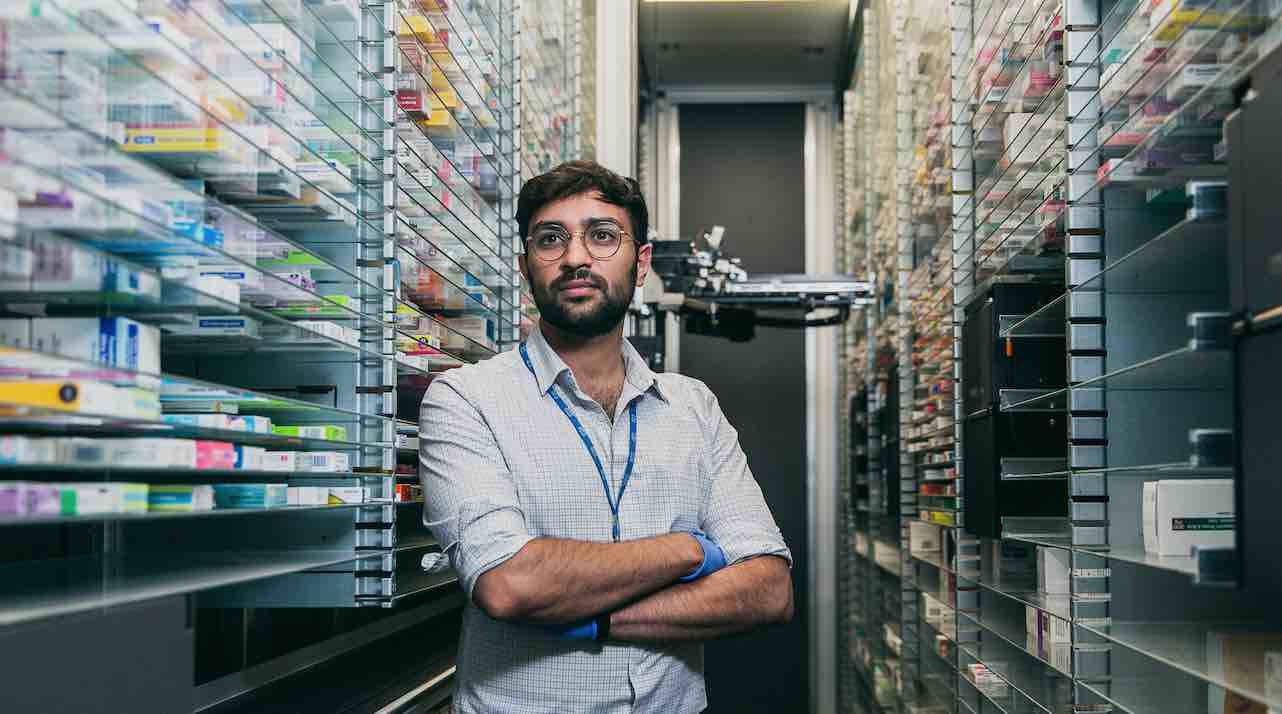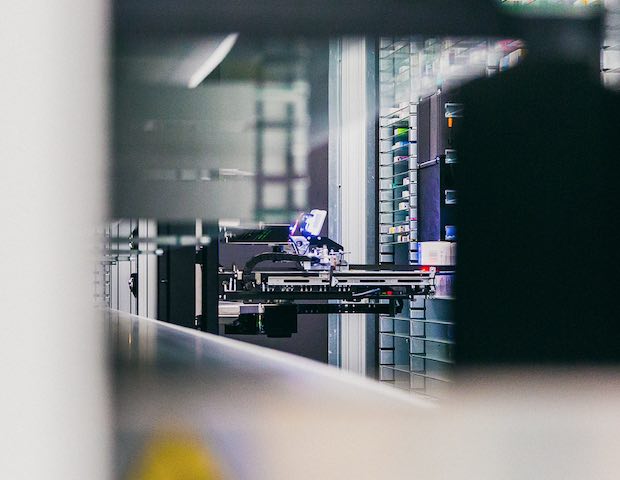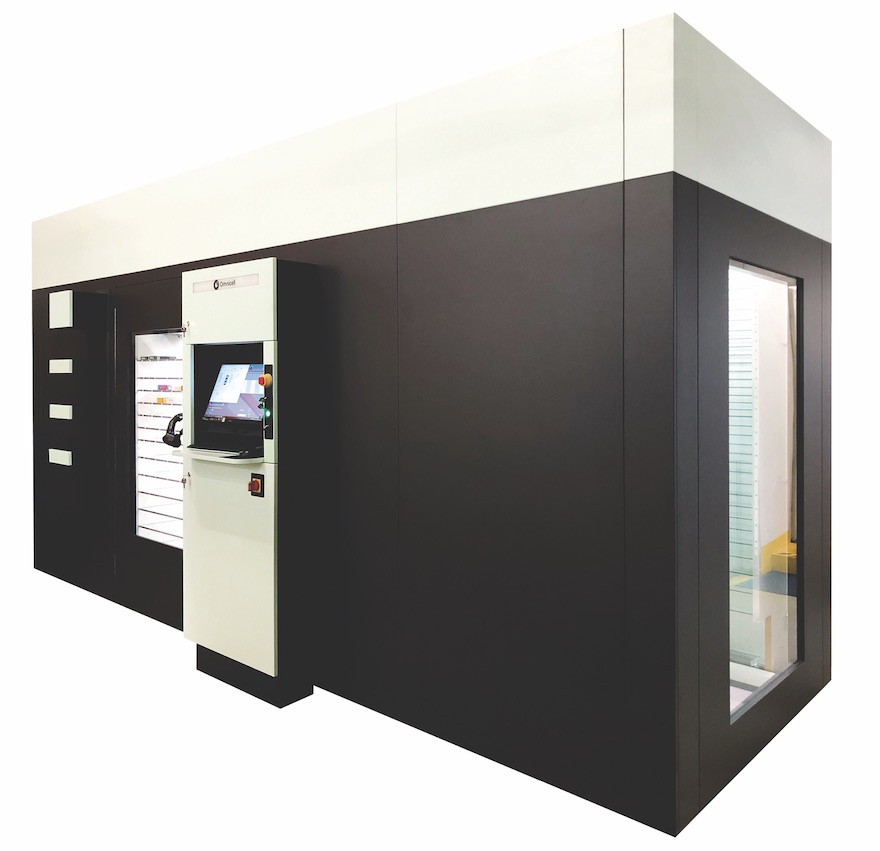Time to hit the button
In Running Your Business
Follow this topic
Bookmark
Record learning outcomes

The pandemic has increased the pressures on community pharmacies, and lockdowns have led to changes in pharmacy practice – paperless prescriptions, more self care advice and increased home delivery. With the shift towards more digital services, efficient pharmacy technology has become increasingly important.
In July 2020, a survey by the National Pharmacy Association (NPA) revealed that the public would support a greater role for pharmacies within the NHS after Covid-19. Seventy-four per cent of respondents said they want community pharmacies to be better integrated with other healthcare services, operating as neighbourhood health and wellbeing centres and providing face-to-face advice.
The Community Pharmacy Contractual Framework for 2019/20 to 2023/24: supporting delivery for the NHS Long Term Plan, published in July 2019, recognised that an expanded community pharmacy role would be dependent on releasing pharmacists from some of their existing workload. One way to do this would be to maximise the opportunities afforded by automation and IT developments to make dispensing more efficient.
Pandemic pressures
According to Gary Paragpuri, chief executive of Hub & Spoke Innovations, distributor of the Pharmaself24 automated prescription collection point, the pandemic has had a significant impact on how pharmacies think about automation. “Pharmacy is competitive,” he says. “Patients are free to choose where they take their custom, but automating certain parts of the process can help a business retain its competitive edge. The shift to a digital, convenience-led way of life has accelerated during lockdown, further driving the acceptance of online services, click-and-collect models and next-day delivery. These are broader societal changes, and they are certainly being felt in pharmacy.”
Cyrus Hodivala, Omnicell’s sales director UK & Ireland, says Omnicell has seen a significant spike in interest in pharmacy automation over the last 12 months. “Covid-19 has obviously pushed the envelope of operation and supply for retail pharmacy,” he says. “Pharmacy owners have had huge staff shortage problems, while their staff are self-isolating or having to look after sick relatives or children.
there is a genuine belief that patient safety should be paramount in these high-pressure working environments
“This has been offset against a degree of public concern around medicine supply challenges driven by both Covid-19 and Brexit. In essence, pharmacies have been driven to serve more customers and issue more meds with fewer staff. This has crystallised just how reliant the pharmacy process is on stable staffing levels. Lastly, there is a genuine belief that patient safety should be paramount in these high-pressure working environments.”
Peter Thnoia, southern and central territory manager at BD Rowa, agrees that demand has increased, with many factors leading pharmacies to look into automation – financial, the impact of Covid-19 and the progression to a different way of working. “The efficiencies are one aspect,” he says. “But another is the ease of use of the systems and how quickly staff can be taught to use them in a safer way than was previously possible. This then leads to all sorts of possibilities as you have freed capacity not just for dispensing staff, but also for the pharmacists themselves, who can then go on to do really interesting work that, before, they were unable to find the time to do.”
 Going down the automation route is a big decision, especially for smaller community pharmacies. Mr Paragpuri says it’s important to identify the key business objectives to help choose the right option. “We have customers who are trying to reduce their opening hours because customer footfall has changed over the years,” he says. “Others are trying to reduce queues as their business has grown in popularity, and others are merging two branches to reflect local surgery changes.”
Going down the automation route is a big decision, especially for smaller community pharmacies. Mr Paragpuri says it’s important to identify the key business objectives to help choose the right option. “We have customers who are trying to reduce their opening hours because customer footfall has changed over the years,” he says. “Others are trying to reduce queues as their business has grown in popularity, and others are merging two branches to reflect local surgery changes.”
According to Mr Hodivala, different types of automation have different monthly dispensing volume triggers. “I would normally recommend that a pharmacy be dispensing more than 10,000 items in order to warrant investing in original pack dispensing (OPD) automation,” he says. “It is at this point that errors start to creep in because of the speed of working required by the staff and where stock put away and expiry rotation become overly cumbersome to do manually.
“The manual assembly of MDS compliance aids can be a timely process. We would typically recommend that any pharmacy that has more than 300 patients on MDS should be looking at some form of automation.”
More time freed up
Mr Thnoia says the automation offering is much richer than even just a few years ago, and now works well at both ends of the market. “The bigger volume pharmacies can implement automation and completely change the internal workflow dynamic,” he says. “Also, at the 3,000 to 5,000 item level, you can change the pharmacy to drive growth.
“You can drive growth from being able to collect a prescription 24/7. Internally, you get all the benefits from the system’s safety, so that once the patients are in your pharmacy, the experience you give them is so far beyond what they are used to. You can then become the trusted provider of their healthcare needs.”
under-resource pharmacies... simply don’t have the time to be able to offer advice to patients in the way that they would want
Freeing up staff would enable pharmacies to concentrate on other instore services and spend more time with their customers – providing the one-to-one advice that customers can’t get online or in supermarkets. Therefore, investing in automation may provide an opportunity for community pharmacies to counter online pharmacy players.”
“Pharmacists could offer advice and build long-term relationships with repeat patients because of their level of service,” says Mr Hodivala. “It should never be underestimated how valued the advice and interaction with a pharmacy professional is to patients when they enter a pharmacy. When a patient is sick, it is only human nature that they feel vulnerable, and they often need the support and confidence that good pharmacist advice can give when receiving their medication.
“Pharmacists are a massively underestimated and underused resource in the medicines adherence infrastructure. However, under-resourced pharmacies under massive financial pressures simply don’t have the time to be able to offer advice to patients in the way that they would want.”
Mr Thnoia agrees that it’s the instore experience that will counter online pharmacies, as these can’t compete within this metric. “What happens when your pharmacy is just as efficient but is providing an experience that develops trust and offers face-to-face services integrated with your patient’s needs?” he says. “The easiest thing for online is if you do nothing, as then it is just a commodity exchange.”
Legislation changes proposed
Proposed changes to regulations, allowing hub and spoke dispensing across different corporate entities, could change the dynamics, opening up automation to smaller pharmacies that wouldn’t otherwise be able to take advantage of the technology.
“It may not lead to an overnight shift,” says Mr Paragpuri. “But, as the sector continues to develop strategies around how central fill operation could help drive efficiencies in workflows and deliver better patient experiences, then hub and spoke will, I’m sure, become one more technological tool in a pharmacist’s business toolbox.”
localised control of stock picked with automation that you can control at a ‘per prescription’ level gives far more accuracy
Mr Hodivala believes that there is a place for this legislation, as not everyone has the funds to invest in every form of automation. However, he says it’s important to find the right balance between buying into a new model with a hub and localised control. “A challenge is the over-reliance on single sources for medication and the release of a pharmacy’s ability to manage their own stock control and purchasing power,” he says. “This could lead to natural monopolies for the supply of medication and an over-reliance on individual sources of supply.
“Bulk-picking solutions don’t save the volume of time that a pharmacy operator might think. If the stock for 30 prescriptions is all dropped into a single tote and supplied to a pharmacy, somebody still needs to sort and check all of that medication, collate it into individual prescriptions, label and bag it. This takes a significant amount of staff time. Having localised control of stock picked with automation that you can control at a ‘per prescription’ level gives far more accuracy and is actually faster to process locally.”
Mr Thnoia says the changes won’t affect bigger pharmacy groups too much, but will help smaller independents who really want to push ahead. “This can allow single operators to look at expanding and using the efficiencies to look at businesses in a different way,” he says. “It also offers the ability to free up resources, to push the offering from the pharmacy so there is a step change in patient experience. Hence driving growth and making the risk of expansion much lower.”
Funding options
When considering automation, funding is a key issue. Mr Hodivala says pharmacy owners often look at the cost of capital equipment purchases and immediately feel that there is no tangible benefit in investing in automation due to the cost. “We try to offer a more pragmatic view from outside a business that is both their livelihood and their life,” he says. “There are tax-efficient methods of being able to amortise capital purchases over multiple tax years in order to reclaim the cost of the automation. Further, we try to help pharmacy owners think creatively about their finance methods, whether that be capital investment, bank loans, long-term leasing with low-cost entry to hardware or other methods of business financing, including any available grants from government.”
According to Mr Paragpuri, funding options are now much more varied. “We’ve seen customers win funding from local charities that are set up to serve the health needs of local populations,” he says. “We’ve seen coronavirus bounce-back loans being put to good use, and now we have the 130 per cent capital allowance announced in the latest budget.” [More on this here.]
Mr Thnoia recommends that pharmacies speak to their accountant or financial provider to find a viable finance option that works for them. “They should see what government tax incentives are available to them and how recent allowances from HMRC can help them make the investment,” he says.
'Automation for the Future. How the right robot can support your pharmacy'. Link to webcasts here
You can hear more from Cyrus Hodivala, Omnicell’s sales director UK & Ireland, by watching P3Pharmacy’s recent webcast Automation for the future. How the right robot can support your pharmacy, run in partnership with Omnicell.

The hour long webcast includes a presentation from Mr Hodivala on the benefits of automation and Omnicell’s vision of the autonomous pharmacy. It also covers questions posed to three panellists who have installed Omnicell’s VBM blister card packaging machines for care and community patients in their pharmacies: John Hagan, managing director and owner of Hagan Pharmacy in Greenock; Anirrudh Patel, owner of Savages Pharmacy, Burnham-on-Crouch, and Mimi Lau, chief operating officer and superintendent pharmacist at Mr Pickford’s Pharmacy Group in Leicester.
Questions from the webcast audience included:
1. Where does liability lie in the event of errors caused by robotic systems?
Mr Hodivala said that ultimate responsibility lies with the superintendent pharmacist, who chooses how to dispense and the mechanisms used. He urged pharmacies not to change their checking processes overnight once they have installed automation. They should first ensure the automation they are putting in is accurate and safe, and continue to do their usual manual checks initially. They can then phase these out slowly over a period of time.
2. How much space is needed for automation?
Mr Hodivala said the Omnicell robot is designed to go through a standard metric doorway (2m by 81cm wide). In addition, pharmacies need a certain amount of desk space (1.5m) and space for wall racking. The typical smallest space is around 10ft2 to work effectively.
3. How does automation work alongside manual dispensing?
Mr Patel said his pharmacy team had to rethink how they grouped patients to do MDS, in order to maximise on time. While the machine is on, they want it to be pumping trays out as efficiently as possible. Ms Lau said it’s important not to underestimate the preparation required in advance (e.g. sorting out stock), so there is maximum efficiency while the machine is on.
4. How long did it take to master the VBM blister card packaging machine?
Mr Hagan said the software was very easy to use, with training completed in around five days. After this, the process was very proficient.
5. What advice would you give to colleagues who are thinking about whether automation is right for them?
Mr Hagan said “Go for it”, as pharmacy needs automation– “Look at the figures.”
Mr Patel said that it’s not viable to say no to more prescriptions or dispensing. So to free up the pharmacy team to be more clinical and patient focused, you need to take other work away. He advised looking at different types of robotics, “as there will be something that works for you.”
Ms Lau said there are lots of machines available so do some research and speak to pharmacists who already have automation installed. It’s also important to have a clear plan about why you want to do it and engage the whole team before making an investment.
